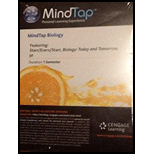
Concept explainers
Introduction:
Individuals in the population carry a specific set of alleles, known as genotype. The examples of genotype are homozygous and heterozygous. The
Answer to Problem 1SQ
Correct answer:
Pair of nonidentical alleles are carried by a heterozygous individual for a trait being studied. Hence, the correct answer is option b.
Explanation of Solution
Reason for correct answer:
Option b. is given as “pair of nonidentical alleles.”
Locus represents the “location of a gene” on a chromosome. Individuals carry two copies of a gene because their cells are diploid and pairs of the chromosome are present in these cells. These double copies of any gene can be similar, or they can vary as alleles. If an individual carries two different alleles or nonidentical alleles at a particular locus then its genotype would be called heterozygous.
Reason for incorrect answer:
Option a. is given as, “pair of identical alleles.”
If an individual has the same allele on both homologous chromosomes then the individual would be known as homozygous. Hence, option a. is incorrect.
Option c. is given as, “a haploid condition, in genetic terms.”
In individuals there are always two copies of genes are present. So, a heterozygous individual is a diploid condition, not a haploid condition. Hence, option c. is incorrect.
Hence, the options a. and c. are incorrect.
Therefore, the pair of nonidentical alleles on both homologous chromosomes would be different in a heterozygous individual. Thus, the correct option is b.
Want to see more full solutions like this?
Chapter 13 Solutions
Mindtap Biology
- A heterozygous individual has _______ for a trait being studied. a. the same allele on both homologous chromosomes b. two different alleles of a gene c. a haploid condition, in genetic termsarrow_forwardIndependent assortment means _______. a. alleles at one locus assort into different gametes b. alleles at different loci tend to assort into gametes independently of each otherarrow_forwardAlleles for Tay-Sachs disease are inherited in an autosomal recessive pattern. Why would two parents with a normal phenotype have a child with Tay-Sachs? a. Both parents are homozygous for a Tay-Sachs allele. b. Both parents are heterozygous for a Tay-Sachs allele. c. New mutations gave rise to Tay-Sachs in the child. d. b or carrow_forward
- If black and white true-breeding mice are mated and the result is all gray offspring, what inheritance pattern would this be indicative of? a. dominance b. codominance c. multiple alleles d. incomplete dominancearrow_forwardYou have a true-breeding strain of miniature-winged fruit flies, where this wing trait is recessive to the normal long wings. How would you show whether the miniature wing trait is sex-linked or autosomal?arrow_forwarda human disease known as cystic fibrosis is inherited as a recessive trait.Two unaffected individuals have a first child with the disease. What isthe probability that their next two children will not have the disease?arrow_forward
- A cross between a horse homozygous for red hair and a horse homozygous for white hair results in offspring with the coat colour called roan. When you look at the fur of the roan offspring you see both red and white hairs. What type of inheritance best explains this? a) blending inheritance b)codominance c)incomplete codominance d)multiple allelesarrow_forwardA man who is red-green color-blind marries a woman who is neither color-blind nor a carrier for this trait. Which statement would best describe their probable offspring?arrow_forwardA man and his wife are both heterozygous for brown eyes. They have ix children all of whom have blue eyes? A) How is it explained? B) What are the chances that their next child will have brown eyes? C) What are the chances that their next child will have blue eyes.arrow_forward
- On occasion, a trait that appears to be autosomal is produced in unexpected ratios in male and female offspring. What is this an example of? A. codominance B. sex-linked genes C. multiple alleles D. amniocentesisarrow_forwardWhen crossing two fruit flies with red eyes, which is a dominant trait, half of the male offspring are born with white eyes, but none of the females are. What is this an example of? A. an autosomal recessive trait B. an autosomal dominant trait C. an X-linked recessive trait D. an X-linked dominant traitarrow_forwardDuchenne's muscular dystrophy is sex-linked and usually affects only males. Victims of the disease become progressively weaker, starting early in life. If your mother's brother (your uncle) had Duchenne's disease, what is the probability that you have received the allele? Show the solution through pedigree analysis.arrow_forward
 Biology Today and Tomorrow without Physiology (Mi...BiologyISBN:9781305117396Author:Cecie Starr, Christine Evers, Lisa StarrPublisher:Cengage Learning
Biology Today and Tomorrow without Physiology (Mi...BiologyISBN:9781305117396Author:Cecie Starr, Christine Evers, Lisa StarrPublisher:Cengage Learning
 Biology: The Dynamic Science (MindTap Course List)BiologyISBN:9781305389892Author:Peter J. Russell, Paul E. Hertz, Beverly McMillanPublisher:Cengage Learning
Biology: The Dynamic Science (MindTap Course List)BiologyISBN:9781305389892Author:Peter J. Russell, Paul E. Hertz, Beverly McMillanPublisher:Cengage Learning Human Biology (MindTap Course List)BiologyISBN:9781305112100Author:Cecie Starr, Beverly McMillanPublisher:Cengage Learning
Human Biology (MindTap Course List)BiologyISBN:9781305112100Author:Cecie Starr, Beverly McMillanPublisher:Cengage Learning Concepts of BiologyBiologyISBN:9781938168116Author:Samantha Fowler, Rebecca Roush, James WisePublisher:OpenStax College
Concepts of BiologyBiologyISBN:9781938168116Author:Samantha Fowler, Rebecca Roush, James WisePublisher:OpenStax College




